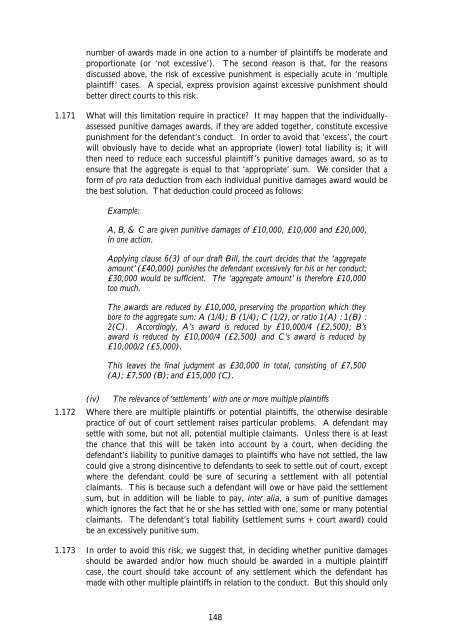Aggravated, Exemplary and Restitutionary ... - Law Commission
Aggravated, Exemplary and Restitutionary ... - Law Commission
Aggravated, Exemplary and Restitutionary ... - Law Commission
Create successful ePaper yourself
Turn your PDF publications into a flip-book with our unique Google optimized e-Paper software.
number of awards made in one action to a number of plaintiffs be moderate <strong>and</strong><br />
proportionate (or ‘not excessive’). The second reason is that, for the reasons<br />
discussed above, the risk of excessive punishment is especially acute in ‘multiple<br />
plaintiff’ cases. A special, express provision against excessive punishment should<br />
better direct courts to this risk.<br />
1.171 What will this limitation require in practice? It may happen that the individuallyassessed<br />
punitive damages awards, if they are added together, constitute excessive<br />
punishment for the defendant’s conduct. In order to avoid that ‘excess’, the court<br />
will obviously have to decide what an appropriate (lower) total liability is; it will<br />
then need to reduce each successful plaintiff’s punitive damages award, so as to<br />
ensure that the aggregate is equal to that ‘appropriate’ sum. We consider that a<br />
form of pro rata deduction from each individual punitive damages award would be<br />
the best solution. That deduction could proceed as follows:<br />
Example:<br />
A, B, & C are given punitive damages of £10,000, £10,000 <strong>and</strong> £20,000,<br />
in one action.<br />
Applying clause 6(3) of our draft Bill, the court decides that the ‘aggregate<br />
amount’ (£40,000) punishes the defendant excessively for his or her conduct;<br />
£30,000 would be sufficient. The ‘aggregate amount’ is therefore £10,000<br />
too much.<br />
The awards are reduced by £10,000, preserving the proportion which they<br />
bore to the aggregate sum: A (1/4); B (1/4); C (1/2), or ratio 1(A) : 1(B) :<br />
2(C). Accordingly, A’s award is reduced by £10,000/4 (£2,500); B’s<br />
award is reduced by £10,000/4 (£2,500) <strong>and</strong> C’s award is reduced by<br />
£10,000/2 (£5,000).<br />
This leaves the final judgment as £30,000 in total, consisting of £7,500<br />
(A); £7,500 (B); <strong>and</strong> £15,000 (C).<br />
(iv) The relevance of ‘settlements’ with one or more multiple plaintiffs<br />
1.172 Where there are multiple plaintiffs or potential plaintiffs, the otherwise desirable<br />
practice of out of court settlement raises particular problems. A defendant may<br />
settle with some, but not all, potential multiple claimants. Unless there is at least<br />
the chance that this will be taken into account by a court, when deciding the<br />
defendant’s liability to punitive damages to plaintiffs who have not settled, the law<br />
could give a strong disincentive to defendants to seek to settle out of court, except<br />
where the defendant could be sure of securing a settlement with all potential<br />
claimants. This is because such a defendant will owe or have paid the settlement<br />
sum, but in addition will be liable to pay, inter alia, a sum of punitive damages<br />
which ignores the fact that he or she has settled with one, some or many potential<br />
claimants. The defendant’s total liability (settlement sums + court award) could<br />
be an excessively punitive sum.<br />
1.173 In order to avoid this risk, we suggest that, in deciding whether punitive damages<br />
should be awarded <strong>and</strong>/or how much should be awarded in a multiple plaintiff<br />
case, the court should take account of any settlement which the defendant has<br />
made with other multiple plaintiffs in relation to the conduct. But this should only<br />
148
















